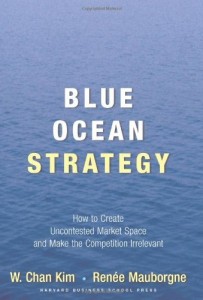 This is an especially thought-provoking book which, as have so many others, evolved from an article published in the Harvard Business Review. According to Kim and Mauborgne, “Blue ocean strategy challenges companies to break out of the red ocean of bloody competition by creating uncontested market space that makes the competition irrelevant…This book not only challenges companies but also shows them how to achieve this. We first introduce a set of analytical tools and frameworks that show you how to systematically act on this challenge, and, second, we elaborate the principles that define and separate blue ocean strategy from competition-based strategic thought.” There are six principles which are introduced and then discussed on pages 49, 82, 102, 117, 143, and 172, respectively.
This is an especially thought-provoking book which, as have so many others, evolved from an article published in the Harvard Business Review. According to Kim and Mauborgne, “Blue ocean strategy challenges companies to break out of the red ocean of bloody competition by creating uncontested market space that makes the competition irrelevant…This book not only challenges companies but also shows them how to achieve this. We first introduce a set of analytical tools and frameworks that show you how to systematically act on this challenge, and, second, we elaborate the principles that define and separate blue ocean strategy from competition-based strategic thought.” There are six principles which are introduced and then discussed on pages 49, 82, 102, 117, 143, and 172, respectively.
Frankly, I was somewhat skeptical that this book could deliver on the promises made in its subtitle. In fact, the material provided by Kim and Mauborgne is essentially worthless unless and until decision-makers in a given organization accept the challenge, are guided
and informed by the six principles, and effectively use the tools within appropriate frameworks. The responsibility is theirs, not Kim and Mauborgne’s. To assist their efforts, Kim and Mauborgne focus on several exemplary companies which have dominated (if not rendered irrelevant) their competition by penetrating previously neglected market space. They include the Body Shop, Callaway Golf, Cirque du Soleil, Dell, NetJets, the SONY Walkman, Southwest Airlines, Starbucks, the Swatch watch, and Yellow Tail wine.
Of greatest interest to me is Kim and Mauborgne’s assertion that the innovations which enabled these companies to succeed with a Blue Ocean strategy did NOT depend upon a new technology. Rather, each company pursued a strategy which enabled it to free itself from industry boundaries. For
Dell, that meant mass production of computers sold directly to consumers per each customer’s specifications. Quite literally, each sale is “customized.” For Callaway, creating an enlarged sweet spot to increase the frequency of solid contact for new or infrequent golfers just as, years ago, the enlarged Head racquet did so for new or infrequent tennis players. For Starbucks, creating a congenial environment within which to socialize, go online, or read while consuming coffee. All of these Blue Ocean strategies created new or much greater value for customers. Their emphasis is on the quality of experience, not on the benefits of a new technology.
According to Kim and Mauborgne, their research indicates that “the strategic move, and not the company or the industry, is the right unit of analysis for explaining the creation of blue oceans and sustained high performance. A strategic move is the set of managerial actions and decisions involved in making a major market-creating business offering.” The cornerstone of a Blue Ocean strategy is value innovation which occurs “only when companies align innovation with utility, price, and cost positions. If they fail to anchor innovation with value in this way, technology innovators and market pioneers often lay the eggs that other companies hatch.” For Kim and Mauborgne, value innovation is about strategy that embraces the entire system of a company’s activities. It requires companies to orient the whole system toward achieving a “leap” in value for both buyers and themselves. Kim and Mauborgne explain HOW to create uncontested market space wherein competition
is essentially irrelevant.
To paraphrase Henry Ford, whether decision-makers think they can or think they can’t do that, they’re right.